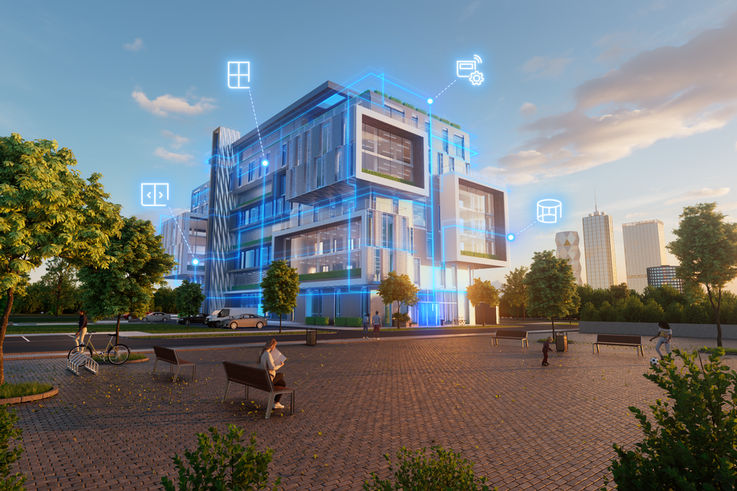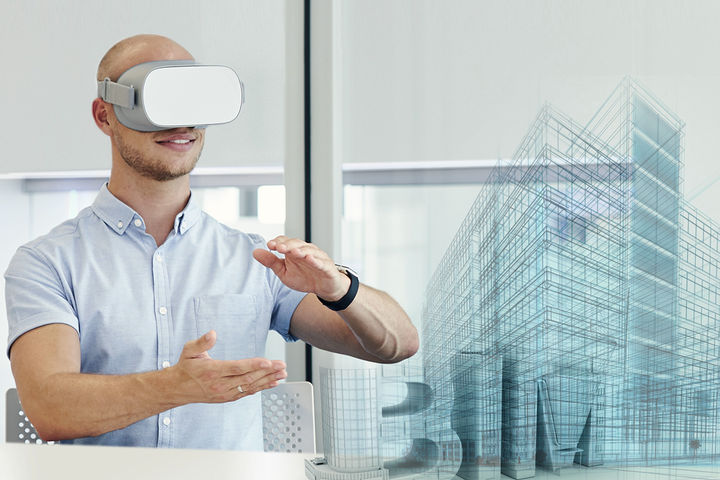AI in architecture: How artificial intelligence is transforming the construction industry
AI-generated architectural designs and 3D building models, AI-controlled processes in the construction phase and AI-monitored buildings: there is no doubt that artificial intelligence (AI) has the potential to fundamentally transform the architecture industry. The hope is that innovative AI technologies will contribute to greater sustainability and efficiency in construction projects - not just from planning to completion, but throughout the entire building life cycle. But how can architecture and construction projects benefit from AI?
Which areas can benefit most from AI as a tool for solving specific problems in the architecture and construction industry?

Building automation offers improved energy efficiency, increased comfort and safety and reduced maintenance costs. © GEZE GmbH
Artificial intelligence can help us to make complex processes easier to understand, analyse and optimise. From the initial design phase through to management of the completed building, AI-based use cases are created that enable resource and time savings for a wide range of stakeholders in the building life cycle.
Positive application examples of AI in the field of architecture and construction could look something like this, for instance:
- Time savings: With the help of AI-based rendering, architects can create drafts and generative designs based on predefined parameters within seconds.
- Collaboration: Collaborative platforms such as BIM (Building Information Modelling) integrate artificial intelligence and facilitate interdisciplinary collaboration between different players in the construction process.
- Cost reduction: AI-based software optimises construction processes by improving schedules and workflows, thereby reducing construction costs.
- Sustainability: Building automation uses AI to improve the sustainability and energy efficiency of buildings, thereby reducing energy consumption, CO2 emissions and other environmental impacts.
- Safety: AI makes it possible to identify structural weak points, potential areas of optimisation and maintenance intervals in building operation.
- Convenience: Personalisation and AI-driven adaptation of Smart Buildings to the specific needs of users.
What are the long-term benefits of integrating innovative technologies into buildings?
Innovative technologies, such as artificial intelligence, are helping to overcome the major challenges facing the construction industry. The focus here is on sustainability in particular. The use of innovative technologies will make it possible to reduce the ecological footprints of buildings over the entire building life cycle, i.e. in the long term. In addition, the economic efficiency and functionality of buildings will be significantly improved.
What new developments and AI technologies is GEZE focussing on?

GEZE window and door drives can be integrated into a building automation system via open interfaces. © GEZE GmbH
The topic of predictive maintenance is particularly interesting at the moment, as GEZE has been working on the topics of networking and automation in buildings for a long time. Our KNX and BACnet interface modules and our building automation system myGEZE Control provide an excellent foundation for predictive maintenance. Because of this, we have various prototypes and research initiatives to test how we can integrate AI into our intelligent products.
At the same time, GEZE is currently testing the use of large language models and other AI technologies in daily operations. In addition to improving internal processes, the aim is to lower the barriers to the use of artificial intelligence and integrate it into employees' day-to-day work.
What role does AI play in collaboration with architects?
Our aim is to solve the challenges facing architects. AI is not necessarily the focus here, but serves as a tool to solve the actual issue. After all, even if AI can provide useful support, direct dialogue and human expertise will remain irreplaceable in the future. This means that we will continue our close dialogue with architects, planners and building contractors in order to understand exactly what is needed – and then develop customised solutions together.
GEZE: Your contact partner in all project phases
Are you looking for a customised solution for your project? GEZE supports specialist planners and architects in all project phases and offers comprehensive project advice on all specifications, solutions and support services.
Contact our GEZE experts via the architects hotline: +49-7152-203-112
To the CONTACT FORM


